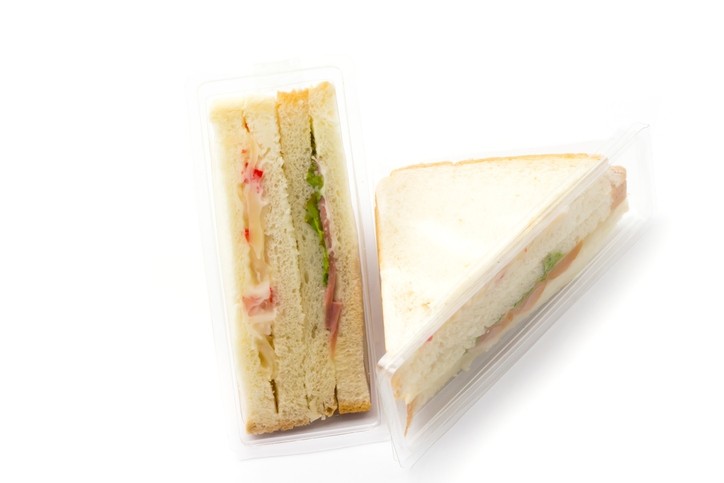Small ingredient tweaks could make packaged sandwiches more eco-friendly

Arguably one of Britain's greatest culinary successes, the UK public eats more than 11.5 billion sandwiches each year - and the number is rising.
Around half of these are prepared at home while the rest are ready-made, pre-packaged sandwiches, part of a sector worth around £7.85 billion (€8.99bn), according to 2017 data from the British Sandwich Association.
Given the sheer size of this industry, researchers from the University of Manchester calculated the carbon footprint of Britain's beloved sandwich in the hope of revealing some ways in which it could be improved.
The most popular ready-made sandwiches in the UK are chicken salad, bacon, lettuce and tomato (BLT), Ploughman’s cheese and egg & cress.
Meat is high – veggie’s not better
The greatest contributor to the carbon footprint of both types of sandwich is the agricultural production of ingredients but for ready-made sandwiches, the preparation and retail stages are "significant", they say.
The researchers looked not just at the environmental impact of the ingredients - cultivating and harvesting the cereals in the UK or rearing prawns at an aquafarm in Scandinavia and then shipping them to the UK, for instance – but also the greenhouse gas emissions associated with the plastic and paper packaging as well as preparing, refrigerating and transporting the sandwiches.
They also took into account food waste and whether packaging materials are dealt recycled.
Overall, sandwiches with a combination of pork meat - bacon, ham or sausages- cheese and prawns had the highest carbon footprints with more than 1200 g equivalent carbon dioxide (CO2eq.).
Sandwiches containing chicken and tuna have the carbon footprint in the range of 769–1258 g CO2 eq. while that of the vegetarian sandwiches ranges from 739 to 1112 g CO2 eq.
“The inclusion of cheese in the vegetarian recipes results in the carbon footprints comparable to or even higher than for some of the meat sandwiches.
"For example, cheese Ploughman’s emits 1112 g CO2 eq. while chicken & bacon produces 1083 g CO2 eq. per serving. This is largely due to the higher carbon footprint of cheese than chicken or bacon.”
Recipe changes
The researchers also said that small tweaks in the recipe can “influence significantly the carbon footprint”.
Small reductions in the amount of meat, eggs and cheese used in ready-made sandwiches could reduce the impact by 1.1–10%.
“Tomato and lettuce are ingredients with a relatively low energy content but can have significant carbon footprints, depending on the cultivation practices considered,” they wrote, and excluding tomato and lettuce lowers the carbon footprint by 3.3%–8.9%.
Omitting mayonnaise could also bring carbon savings of between 1.7%–8.4%.
This could cause headaches for sandwich manufacturers, however, as mayonnaise also has a number of functional properties, acting as a barrier between the filling and the bread, it prevents the bread from turning soggy. It is also used as a carrier for other ingredients such as chicken, tuna and sweetcorn so they can be easily spread over the bread.
Despite this, there may be other reasons to cut the mayo: its high energy content. “Excluding mayonnaise, which is a ubiquitous sandwich filling, would also reduce the energy (and fat) content, in the interest of a healthier diet.”
The study also looked at improvements to the plastic packaging, such as replacing the base-case PET with cardboard. These kind of reductions range from 2.5% to 9.5%.
Food waste
One of the main reasons home-made sandwiches have a lower carbon footprint than commercial sandwiches is due to the use of resources along the supply chain.
“Food losses along the supply chain of commercial sandwiches imply that 20.5% more ingredients are actually required to deliver one sandwich at the retail stage,” write the authors.
For food safety and logistical reasons ready-to-eat sandwiches in the UK have a very short shelf life of only two days. Relaxing the use-by date would help save at least 2000 tonnes of sandwich waste annually, according to the BSA.
Similar reductions can be achieved by reducing the amount of food waste in the supply chain (3.1%–8.5%) and by adopting waste management options other than landfilling, combined with changes in sandwich packaging (2.5%–9.5%).
Source: Sustainable Production and Consumption
“Understanding the impact on climate change of convenience food: Carbon footprint of sandwiches”
Available online ahead of print, https://doi.org/10.1016/j.spc.2017.12.002
Authors: Namy Espinoza-Orias, Adisa Azapagic











